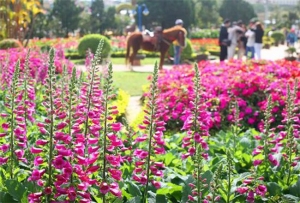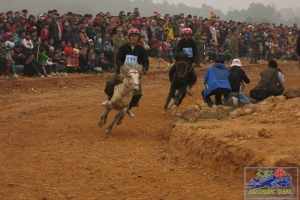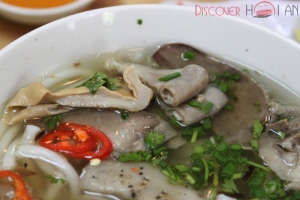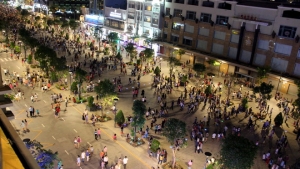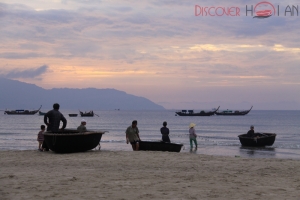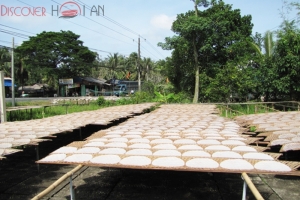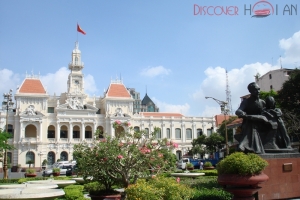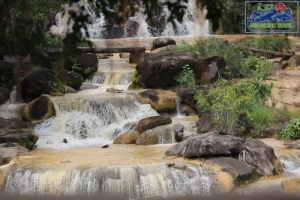
Asia Pacific Travel Team
Da Lat Flower Festival 2015
Bac Ha horse racing festival
Banh canh Ben Co - A specialty of Tra Vinh
Few people know that the rustic but delicious banh canh Ben Co (Ben Co rice noodle soup), now a famous dish in the south, originated in a small roadside eatery on National Highway 53 in Ben Co Hamlet, Nguyet Hoa Commune, Chau Thanh District, Tra Vinh Province.
In the past, many people who had a chance to pass by Ben Co Hamlet often visited the restaurant. Thanks to its local fame, banh canh Ben Co became known not only in the Mekong Delta but in Saigon and has been brought to several national food festivals.
Ingredients for making the dish include lean meat, pig bowels, rice noodle and spices. Apart from spices, the noodle itself plays a role in ensuring the quality of a bowl of banh canh Ben Co. The noodles must be made from old rice, which is harvested in May and stored until October because new rice makes noodles soft and easily broken.
Rice will be ground in water to become flour. After that, people would work the flour into dough, which will then go through a funnel into boiling water before it is quickly taken out and then dipped into cold water for five minutes.
To have clear and sweet broth, pig’s meat and bones must be carefully chosen and cleaned before they are stewed over a small fire. Froth is taken out continuously to make the broth clear. The pot of broth will be added with onions and grilled shallots to make the taste sweeter and more fragrant.
Lean meat and pig’s bowels are cleaned with salt and lemon as a way to deodorize them. Then, they are boiled with a small spoon of vinegar to make them white. They will not be boiled in the broth or else it will be cloudy.
A bowl of banh canh Ben Co will have a layer of banh canh which is covered with boiled meat and bowels, green onions, and pepper before the broth is poured over. It is served with a small bowl of fish sauce and lime.
Source: SGT
Nguyen Hue pedestrian street has wifi available
District 1 authorities said they were also planning to install 160 benches made from the wood of trees that once stood on the street and were later cut down to make room for construction of a subway line.
The walking street was built with an investment of VND430 billion (US$20 million). It is 670m in width and 64m in length. Since the opening last month, it has attracted thousands of visitors every day.
Da Nang listed in the top low-cost destinations in summer 2015
The famous U.S travel website Skyscanner has recently voted the top low-cost destinations in summer 2015, including Da Nang City (Viet Nam).
According to Skyscanner, Da Nang is the tropical destination for adventurous tourists with low cost. Tourists will have the opportunity to experience an exciting summer at sea and also enjoy the rustic dishes of the Central Viet Nam.
Located in the South Central Coast, Da Nang City has the diverse terrain, including mountains alternated with coastal plain, forming many beautiful natural sceneries, such as Ba Na Mountain, Mable Mountains, Son Tra Peninsula, Non Nuoc Beach, My Khe Beach... It also contains many unique culture features such as: traditional festivals (Avalokitesvara Festival, Ca Ong Festival...), craft villages (Cam Ne Mat Village, Non Nuoc Stone Sculpture Village), cuisine (Tuy Loan rice paper, Cam Ne dried sesame cake, Nam O fish salad…), architectural works (Linh Ung Pagoda, Tam Thai Pagoda, Han Market, Nguyen Hien Dinh Classical Opera Theatre, Dragon Bridge, Han River Bridge…)… They all affirm the modern and dynamic development of the coastal city.
The top low-cost destinations in summer 2015 also includes Malaga (Spain), Ibiza (Spain), Algarve (Portugal), Pula (Croatia), Nice (France), Antalya (Turkey), Sharm el Sheikh (Egypt), Bali (Indonesia) and Orlando (Florida).
Thu Giang
My Long - The rice paper making village
Having heard of the rustic rice paper made from rice and coconut milk and grilled over burning coal, I took part in the process of making the cake from mixing rice flour with coconut milk, spreading dough to grilling the cake. Rice paper makers in My Long are truly artisans.

The type of rice used for producing this cake should be grown in Tra Vinh Province because it is drought-resistant. Meanwhile, coconuts used for the cake must come from My Long area because sweeter and greasier coconut milk can be extracted from their flesh.
With rice flour and coconut milk as two main ingredients, people in My Long turn out different types of rice paper with different flavors as they add sesame, milk, yolk, ginger, Chinese barbecue and dried shrimp.
Only experienced makers are able to mix rice flour with coconut milk and spread dough. Dough should not be sticky and the cake should be thin and have a perfect round shape.
After being spread, rice paper cakes will be put on plates made from coconut leaves. The cake must be dried by enough sunlight because they can be crunchy and easy to be broken if it is exposed to much sunlight.
The cake must be grilled on burning coal and the maker is required to quickly turn over the cake constantly to make it well done.
More visitors come to Ho Chi Minh City
Ho Chi Minh City catered for over 300,000 foreign visitors in May, 3.7 percent higher than last May, according to the municipal People’s Committee.
May’s figure raised foreign arrivals in the city to over 1.85 million in the past five months, reflecting a rise of 5 percent year on year.
The outcomes were attributed to a number of measures being employed by the authority to attract more visitors in 2015.
The city’s tourism sector has organised a wide range of domestic and international promotional events, such as the Southern Cuisine Festival or the Southern Fruit Festival.
A series of books and maps have been published in English in order to help international tourists around town.
The city also launched a website and hotline (call 1087) to provide tourism information.
The municipal Department of Tourism plans to improve the quality and diversity of tourism services, including waterway tourism and art performances throughout the city.
Source: VNA
Bac Ha plum tree gardens attract visitor to Lao Cai
People from the south – especially big cities like HCM City and Can Tho – think of plums as a Ha Noi specialty. But in reality they're grown on Bac Ha Plateau, 340km from the capital.
After four of my friends and I left Ha Noi's noisy streets in the scorching heat one summer morning, we arrived in Bac Ha District in the afternoon. The region's climate was much cooler – with an average temperature of 21 degrees. Luxuriant plum tree gardens flanking the mountain pass made a strong impression on us.
We booked a night at the Sunday Hotel and later, while we were taking a walk, the receptionist invited us to her family's plum tree garden.
We followed the receptionist, Nguyen Thi Ha, to Na Hoi Commune – 2km from Sunday Hotel in the centre of Bac Ha District.
Ha said she left her hometown in Nam Dinh Province's Hai Hau District 10 years ago. She went to Lao Cai and married a man from the Day ethnic minority.
The couple came to Bac Ha District centre and settled on a mountainous plot of land.
We parked our car at the foot of a sloping street and walked to Ha's 30-tree plum garden next to her one-floor corrugated iron-roof timber house.
We felt relaxed there walking around the garden. Like her neighbours', Ha's house was built in the middle of her plot of land.
Ha let us pick the ripe fruits and eat them for free. The trees were weighed down with the fruits. Bac Ha's climate is suitable year-round for growing Tam Hoa plums, apricots and herbs.
Ha and her husband, a carpenter, gave us a warm welcome. Ha told us about tree-growing, farming and selling. "I have a stable income from working at the hotel, and we farm plums to save money and support our 7-year-old daughter's schooling," Ha said. "I'll take her to a high school in Lao Cai, 70km from Bac Ha. I hope she can learn a foreign language to prepare her for her career."
Bac Ha's plum season starts in late May. The mountain fields are always lush with ripe fruit in June and July.
Sweetest fruit
Plums in Bac Ha, called Tam Hoa plums, are different from those in other regions. Bac Ha's plums are greenish-red, while those of Lang Son District are pink.
Out of all of Viet Nam's different plums, most say Bac Ha's are the tastiest because they're so sweet and have small pits. The region is called the White Plateau because it's home to more than 1,000ha of plum trees. It's the northwest region's biggest plum-growing area.
Tam Hoa plum farming has helped thousands of ethnic minority households in Bac Ha District escape poverty. Bac Ha is home to the Mong, Nung, Tay and Phu La ethnic minority groups.
Plum season is prime tourist season in Bac Ha. In recent years it has lured a huge number of foreign and domestic visitors.
A friend of mine, a professional phuot (backpacker), told me that if I had a chance to visit the region in early March I could gaze down at the entire Bac Ha valley covered in a carpet of white plum blossoms – an image straight out of a watercolour painting.
Ha and her husband sold their fruit in bulk to traders at Coc Leu Market in Lao Cai City's centre.
Ethnic minority women carry plums on their backs to central markets early every morning. A seller told us that the price of one kg of plums fluctuated between VND20,000 to 40,000 (about $1 to $2) depending on the fruit's size and ripeness.
Source: VNS
Discovering Chu B'Luk volcano in Centre Highlands
The Chu B’Luk volcano system in Buon Choah Commune, Krong No District, Dak Nong Province is a must-visit destination for those loving to explore caves and especially, volcanoes.
The trace of the operation of a volcano appears right on the path leading to the foot of the volcano as it is full of frothy basaltic rock created from lava which the volcano spewed in the past.

Passing the basalt reef, the trip to Chu B’Luk volcano continues with a long slope which leads straight to the volcano crater. After passing through several obstacles during the journey, the feeling of setting foot on top of the volcano which is 593 meters above sea level and admiring the cone-shaped crater is a once-in-a lifetime experience that mountain climbers should give a try.
Surrounding the carter is a cave system created by lava over the years. Visiting the place, tourists will be given safety shoes, torch and a long stick to explore the caves together with a tour guide.
At present, local authorities do not allow visitors to enter C7 Cave, the longest cave in Southeast Asia that is more than 1,000 meters long.
However, the exploration of other caves, including C1 Cave which is around 300 meters long, may make tourists thrilled thanks to the magnificent lava layers and stones as well as the fanciful light beams shinning down through a sky well.
Currently, several tourism companies in HCMC offer three-day and two-night tours departing from the city to Dak Nong that include visits to the Chu B’Luk volcano system. The tour costs some VND2.3 million (US$105) per person.
Source: SGT
Colorful garden around Yang Bay waterfall
Located inside Yang Bay eco-tourism site covering 570 hectares in Khanh Vinh, a mountainous district around 600 meters above sea level in Khanh Hoa Province, Yang Bay Waterfall tourist area is a true heaven for those loving natural landscapes, especially flowers and trees.
From the beautiful beach city of Nha Trang, tourists can take a bus to travel 50 kilometers through villages of local people to reach Yang Bay Waterfall.
Halfway to the waterfall, the bus drops by a tree which is called “God tree” by locals. It is created by a vine tree and a weeping fig tree that twist together with a height of 25 meters, a canopy spreading more than 200 square meters, and a large trunk that takes more than 20 people to stretch arm-to-arm to wrap around. According the elders, this must be more than 300 years old.
Near the tree is a lake where a species of “King lotus” grows. King lotus flowers have different colors at different times. When it is in full blossom on the first day, its milky white petals will emit intoxicating perfume. On the second day, its petals will fold up into a bud. When night falls, it will blossom again, and this time its petals will become dark red. With a diameter of almost two meters, its leaves look like huge basins, which can support a baby’s weight.
Starting from the tree, tourists can stroll down a path full of flowers on the two sides to reach Phoenix hill which looks like a phoenix.
Not far from the tree is the entrance to Yang Bay Waterfall tourist area. Once entering the park surrounding the waterfall, visitors will be thrilled by the colorful garden of gliricidia with its flowers in a bright pink tinged with white.
More surprisingly, deep in the garden, where green grasses grow on the ground, white horses leisurely enjoy fresh grasses near a flock of white storks.
The paths inside the garden are decorated with wild orchids and bougainvillea. Swings are also put around the garden for tourists to take a break and enjoy the airy atmosphere.
Right next to the gliricidia garden is a rose garden which covers thousands of square meters and is home to more than 50 rose species. On special days such as Valentine’s Day, visitors can get free fresh roses.
Another type of flower which also contributes to the unique beauty of the park is golden lotus banana, which grows on the mountain side.
With the fresh and airy atmosphere and a large flower cultivation area, Yang Bay Waterfall tourist area is worth visiting.
Source: SGT


